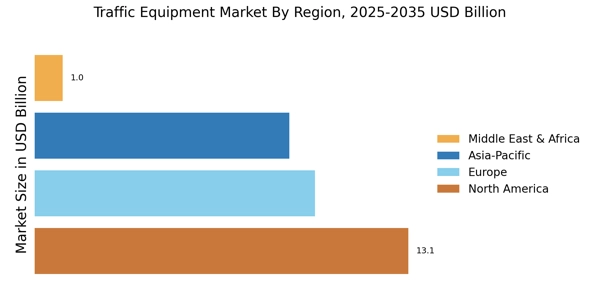Rising Urbanization
The Traffic Equipment Market is experiencing a notable surge due to increasing urbanization. As populations migrate towards urban centers, the demand for efficient traffic management solutions escalates. Urban areas are often characterized by high vehicle density, necessitating advanced traffic equipment to ensure smooth flow and safety. According to recent data, urban populations are projected to reach 68% by 2050, which could lead to a significant rise in traffic congestion. This trend compels municipalities to invest in modern traffic signals, intelligent transportation systems, and other equipment to manage the growing number of vehicles. Consequently, the Traffic Equipment Market is likely to expand as cities seek to enhance their infrastructure to accommodate this urban influx.
Technological Advancements
Technological advancements play a pivotal role in shaping the Traffic Equipment Market. Innovations such as artificial intelligence, machine learning, and IoT are revolutionizing traffic management systems. These technologies enable real-time data collection and analysis, allowing for more efficient traffic flow and improved safety measures. For instance, smart traffic lights that adapt to real-time traffic conditions can reduce congestion and enhance travel times. The market for smart traffic management solutions is expected to grow significantly, with estimates suggesting a compound annual growth rate of over 15% in the coming years. As cities increasingly adopt these technologies, the Traffic Equipment Market is poised for substantial growth.
Growing Focus on Road Safety
The growing focus on road safety is significantly influencing the Traffic Equipment Market. With rising accident rates and fatalities, there is an increasing demand for equipment that enhances safety on the roads. This includes advanced traffic signals, speed cameras, and pedestrian safety systems. Recent statistics indicate that road traffic injuries are a leading cause of death globally, prompting governments and organizations to implement stricter safety regulations. As a response, the Traffic Equipment Market is likely to see a surge in demand for innovative safety solutions that can mitigate risks and protect road users. This trend underscores the importance of prioritizing safety in traffic management.
Government Investments in Infrastructure
Government investments in infrastructure are a critical driver for the Traffic Equipment Market. Many governments are prioritizing the development of transportation infrastructure to support economic growth and improve public safety. This includes funding for road expansions, bridge repairs, and the installation of modern traffic management systems. Recent reports indicate that infrastructure spending is expected to increase by 10% annually, reflecting a commitment to enhancing transportation networks. Such investments not only create jobs but also stimulate demand for traffic equipment, as municipalities seek to upgrade their systems. As a result, the Traffic Equipment Market stands to benefit from these ongoing government initiatives.
Environmental Regulations and Sustainability Initiatives
Environmental regulations and sustainability initiatives are becoming increasingly influential in the Traffic Equipment Market. As concerns about climate change and pollution grow, governments are implementing stricter regulations aimed at reducing emissions from vehicles. This has led to a push for the adoption of eco-friendly traffic management solutions, such as electric traffic signals and systems that promote public transportation. The market for sustainable traffic equipment is projected to grow, with estimates suggesting a rise of 12% annually. This shift towards sustainability not only addresses environmental concerns but also aligns with the broader goals of urban planning and development. Consequently, the Traffic Equipment Market is adapting to meet these evolving demands.


















Leave a Comment